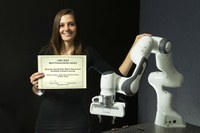The best presentation award of the Conference on Robot Learning goes to Noémie Jaquier, PhD student at Idiap
When someone gives you a hand, you usually respond by giving your hand and shaking it. The choice of this specific scenario is obviously based on your assumptions about what a hand shake implies in terms of movement and on your ability to adapt your handshake to the situation, typically to the location of the other person. To interact properly with humans, robots must be able to learn skills and to adapt them to new contexts.
Among available machine learning techniques that are used in robotics, the Bayesian optimization technique is particularly well adapted for robot to safely and quickly learn new skills or adapt their behavior to new conditions. Member of the Robot learning & interaction group, Noémie Jaquier presented in her paper how to introduce prior geometric assumptions into the Bayesian optimization technique to enhance it in particular situations where the technique seems to lose its advantage. To achieve her goal, the researchers used specific mathematics tools.
Probability needs geometry
Bayesian optimization is widely used in robotics to optimize parameters in relation with robot control and their learning abilities. However, the performance of this approach may be seriously compromised when the number of parameters, called the dimension of the parameters, to be learned is high. As each component of the parameters needs to be optimized, the accumulation slows down the optimization process. Using mathematical tools developed in geometry, the researchers showed how the particular properties of some robotic parameters can be used to improve the efficiency and the quality of the optimization process.
Noémie and her colleagues tested their approach in several benchmark functions and in robotic simulations. They used in particular a simulated robot with seven different articulations to learn orientation and impedance – the measure of opposition to motion when a force is applied – parameters for manipulation skills.
More information
- Conference on Robot Learning (CoRL) and Noémie’s presentation video
- Noémie Jaquier’s paper: Bayesian Optimization Meets Riemannian Manifolds in Robot Learning
- Robot learning & interaction group
- Noémie Jaquier’s website
